Related Research Articles

Olive Oyl is a cartoon character created by E. C. Segar in 1919 for his comic strip Thimble Theatre. The strip was later renamed Popeye after the sailor character that became the most popular member of the cast; however, Olive Oyl was a main character for a decade before Popeye's 1929 appearance.

Bluto, at times known as Brutus, is a cartoon and comics character created in 1932 by Elzie Crisler Segar as a one-time character, named "Bluto the Terrible", in his Thimble Theatre comic strip. Bluto made his first appearance on September 12 of that year. Fleischer Studios adapted him the next year (1933) to be the main antagonist of their theatrical Popeye animated cartoon series.

Popeye the Sailor Meets Sindbad the Sailor is a 1936 two-reel animated cartoon short subject in the Popeye Color Specials series, produced in Technicolor and released to theatres on November 27, 1936, by Paramount Pictures. It was produced by Max Fleischer for Fleischer Studios and directed by Dave Fleischer, with the title song's music composed by Sammy Timberg and lyrics written by Bob Rothberg. The voice cast includes Jack Mercer as Popeye, Gus Wickie as Sindbad the Sailor, Mae Questel as Olive Oyl and Lou Fleischer as J. Wellington Wimpy.

Popeye the Sailor Meets Ali Baba's Forty Thieves is a two-reel animated cartoon short subject in the Popeye Color Specials series, produced in Technicolor and released to theatres on November 26, 1937 by Paramount Pictures. It was produced by Max Fleischer for Fleischer Studios, Inc. and directed by Dave Fleischer. Willard Bowsky was head animator, with musical supervision by Sammy Timberg. The voice of Popeye is performed by Jack Mercer, with additional voices by Mae Questel as Olive Oyl, Lou Fleischer as J. Wellington Wimpy and Gus Wickie as Abu Hassan.
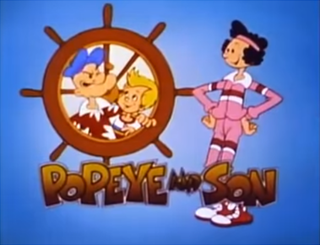
Popeye and Son is an American animated comedy series based on the Popeye comic strip created by E.C. Segar and published by King Features Syndicate. Jointly produced by Hanna-Barbera and King Features subsidiary King Features Entertainment, the series aired for one season of thirteen episodes on CBS from September 19 to December 12, 1987. It is a follow-up to The All New Popeye Hour. Due to Jack Mercer's death in 1984, Maurice LaMarche voiced Popeye, while much of the cast of The All New Popeye Hour reprised their respective roles, with the exception of Daws Butler. However, Nancy Cartwright, who was trained by Butler, voiced Woody in the series.
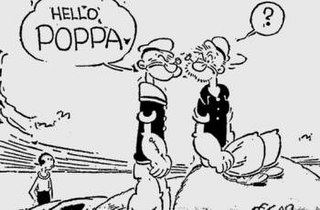
Poopdeck Pappy is a fictional character featured in the Popeye comic strip and animated cartoon spinoffs. Created by E. C. Segar in 1936, the character is Popeye's father, who is between the ages of 85 and 99.
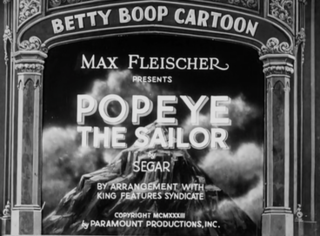
Popeye the Sailor is a 1933 animated short produced by Fleischer Studios and distributed by Paramount Publix Corporation. While billed as a Betty Boop cartoon, it was produced as a vehicle for Popeye in his debut animated appearance.
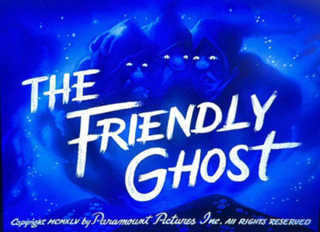
The Friendly Ghost is a Famous Studios cartoon released on 16 November 1945 as part of its Noveltoons series of animated short films. It is the first cartoon to feature the character Casper the Friendly Ghost.

Popeye the Sailor is an American animated television series produced for King Features Syndicate TV starring Popeye that was released between 1960 and 1963 with 220 episodes produced. The episodes were produced by multiple animation studios and aired in broadcast syndication until the 1990s.

The All New Popeye Hour is an American animated television series produced by Hanna-Barbera Productions and King Features Entertainment. Starring the comic strip character Popeye, the series aired from 1978 to 1983 Saturday mornings on CBS. Despite the series' mixed reception, it was a hit for King Features Entertainment.

Popeye the Sailor is an American animated series of short films based on the Popeye comic strip character created by E. C. Segar. In 1933, Max and Dave Fleischer's Fleischer Studios, based in New York City, adapted Segar's characters into a series of theatrical cartoon shorts for Paramount Pictures. The plotlines in the animated cartoons tended to be simpler than those presented in the comic strips, and the characters slightly different. A villain, usually Bluto, makes a move on Popeye's "sweetie", Olive Oyl. The villain clobbers Popeye until he eats spinach, giving him superhuman strength. Thus empowered, Popeye makes short work of the villain.
Spooky Swabs is a Popeye theatrical cartoon short, starring Jack Mercer as Popeye, Mae Questel as Olive Oyl and Mercer, Jackson Beck, Sid Raymond and Gilbert Mack as the ghosts. Produced by Paramount Cartoon Studios and directed by Isadore Sparber, it was released in 1957 and is the final cartoon in the Popeye series of theatrical cartoons released by Paramount Pictures.

Popeye the Sailor is a fictional cartoon character created by Elzie Crisler Segar. The character first appeared on January 17, 1929, in the daily King Features comic strip Thimble Theatre. The strip was in its tenth year when Popeye made his debut, but the one-eyed sailor quickly became the lead character, and Thimble Theatre became one of King Features' most popular properties during the 1930s. Following Segar's death in 1938, Thimble Theatre was continued by several writers and artists, most notably Segar's assistant Bud Sagendorf. The strip continues to appear in first-run installments on Sundays, written and drawn by R. K. Milholland. The daily strips are reprints of old Sagendorf stories.

The Paneless Window Washer is a 1937 Popeye theatrical cartoon short in the Max Fleischer Cartoon series directed by Dave Fleischer.
Ghosks is the Bunk is a 1939 animated short starring Popeye, Olive Oyl and Bluto. Olive reads a ghost story to Popeye and Bluto. Bluto leaves and rigs a haunted house and lures them to it. But they quickly discover him and, even better, a can of invisible paint, and they get the better of him.

Blow me Down! is a Popeye theatrical cartoon short in the Paramount Picture short series. It was released in 1933 and was the third cartoon in the Popeye the Sailor series of theatrical cartoons released by Paramount Pictures. The title also corresponds to one of Popeye's most notable catchphrases.

Seasin's Greetinks! is a Popeye theatrical Christmas-themed cartoon short, starring Billy Costello as Popeye and Bonnie Poe as Olive Oyl and William Pennell as Bluto. It was released on December 17, 1933 and is in the Popeye the Sailor series of theatrical cartoons released by Paramount Pictures.

Let's You and Him Fight is a Popeye theatrical cartoon short released in February 16, 1934, starring Billy Costello as Popeye, Bonnie Poe as Olive Oyl, William Pennell as Bluto and Charles Lawrence as the announcer.
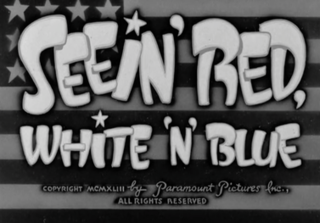
Seein' Red, White 'N' Blue is a 1943 American propaganda cartoon short featuring Popeye directed by Dan Gordon and Jim Tyer. The cartoon revolves around Bluto trying to escape the draft but ends up fighting alongside Popeye against some Japanese spies, Hirohito and Adolf Hitler.
Ancient Fistory is a 1953 American animated short film directed by Seymour Kneitel and starring Jack Mercer in multiple roles. The film was released by Paramount Pictures on January 30, 1953. It was based on a gender-reversed parody of the fairy tale Cinderella and a possible inspiration for the 1960 filmCinderfella starring Jerry Lewis.
References
- ↑ FilmAffinity
- ↑ Cartoons Considered For An Academy Award – 1954-Cartoon Research
- ↑ MUBI
- ↑ Lenburg, Jeff (1999). The Encyclopedia of Animated Cartoons. Checkmark Books. pp. 123–124. ISBN 0-8160-3831-7.
- ↑ Internet Archive
- ↑ BCDB.com [ dead link ]